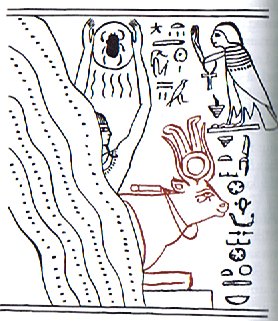|
5. Allen: "It is the only star known to us with absolute certitude in the Egyptian records - its hieroglyph, a dog, often appearing on the monuments and temple walls throughout the Nile country. Its worship, chiefly in the north, perhaps, did not commence till about 3285 B.C., when its heliacal rising at the summer solstice marked Egypt's New Year and the beginning of the inundation, although precession has now carried this rising to the 10th of August. At that early date, according to Lockyer, Sirius had replaced γ Draconis as an orientation point, especially at Thebes, and notably in the great temple of Queen Hatshepsu, known to-day as Al Dēr al Bahāri, the Arabs' translation of the modern Copt's Convent of the North. Here it was symbolized, under the title of Isis Hathor, by the form of a cow with disc and horns appearing from behind the western hills." Earlier (cfr at Camp 8) we have seen a picture of her, emerging horizontally from the 'water':
Allen's year 3285 B.C. implies the precession ought to have moved the date forward from midsummer with about 5285 / 72 = 73 days, which means Sirius should nowadays be rising neither at midsummer nor at the 10th of August but later. Yesterday I happened to hear that the Ethiopean new year is celebrated early in September, which is closer to the expected date of the heliacal rising of Sirius. Wikipedia: "Enkutatash is the word for the Ethiopian new year in Amharic, the official language of Ethiopia, while it is called Ri'se Awde Amet (Head Anniversary) in Ge'ez, the term preferred by the Ethiopian Orthodox Church. It occurs on September 11 in the Gregorian calendar, except for leap years, when it occurs on September 12 ... Enkutatash means the 'gift of jewels'. When the famous Queen of Sheba returned from her expensive jaunt to visit King Solomon in Jerusalem, her chiefs welcomed her bolts by replenishing her treasury with inku or jewels. The spring festival has been celebrated since this early times and as the rains come to their abrupt end, dancing and singing can be heard at every village in the green countryside. The date traditionally marks the end of the season of heavy rains ..." The last comment is what we should expect from the picture above. Spring equinox (north of the equator) + 102 days (the current position of the heliacal rising of Sirius) leads us, however, to a date only slightly beyond midsummer. If we count with 90 days per quarter Sirius should rise around day number 192 counted from winter solstice. The mystery of why Sirius still remains close to midsummer (north of the equator) can be solved if we consider how this star moves against the background of the sky roof in a way which compensates for the effects of the precession: "The Sothic cycle was based on what is referred to in technical jargon as 'the periodic return of the heliacal rising of Sirius', which is the first appearance of this star after a seasonal absence, rising at dawn just ahead of the sun in the eastern portion of the sky. In the case of Sirius the interval between one such rising and the next amounts to exactly 365.25 days - a mathematically harmonious figure, uncomplicated by further decimal points, which is just twelve minutes longer than the duration of the solar year." (Graham Hancock, Fingerprints of the Gods.) Allen's date the 10th of August is another matter, and I suspect the explanation can be found somewhere here: "Its heliacal rising 400 years before our era, corresponded with the sun's entrance into the constellation Leo, that marked the hottest time of the year, and this observation, originally from Egypt, taken on trust by the Romans, who were not proficient observers, and without condsiderations to its correctness for their age and country, gave rise to their dies canicularie, the dog days, and the association of the celestial Dog and Lion with the heat of midsummer. The time and duration of these days, although not generally agreed upon in ancient times, any more than in modern, were commonly considered as beginning on the 3d of July and ending on the 11th of August, for such were the time and period of the unhealthy season of Italy, and all attributed to Sirius." (Allen) |
